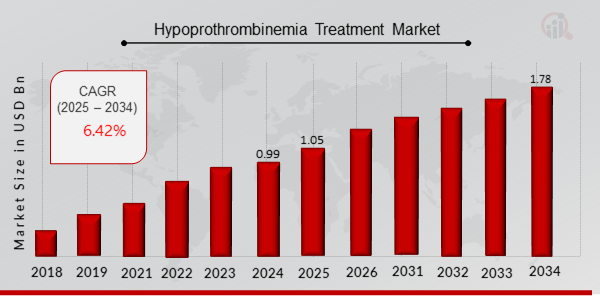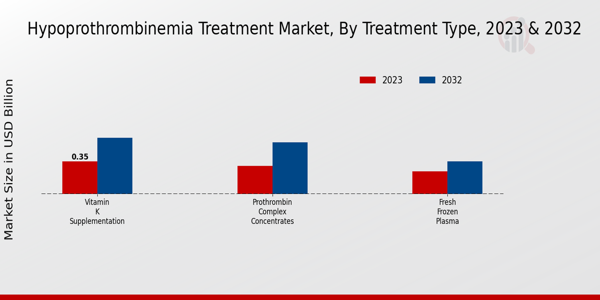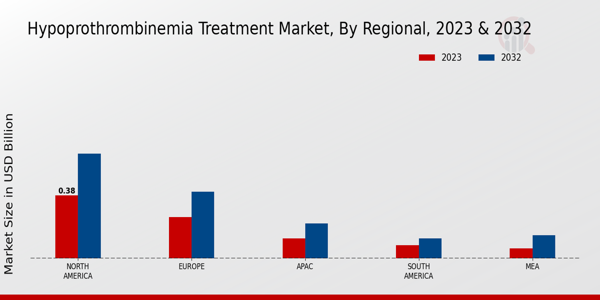Hypoprothrombinemia Treatment Market Overview
As per MRFR analysis, the Hypoprothrombinemia Treatment Market Size was estimated at 0.99 (USD Billion) in 2024. The Hypoprothrombinemia Treatment Market Industry is expected to grow from 1.05 (USD Billion) in 2025 to 1.78 (USD Billion) till 2034, at a CAGR (growth rate) is expected to be around 6.04% during the forecast period (2025 - 2034).
Key Hypoprothrombinemia Treatment Market Trends Highlighted
The Hypoprothrombinemia Treatment Market is experiencing significant shifts due to various drivers, such as the increasing prevalence of bleeding disorders, greater awareness and diagnosis of medical conditions, and advancements in treatment options. Due to the growing understanding of hypoprothrombinemia and its implications, there is a heightened demand for effective therapies. The rise in research and development initiatives aimed at identifying better treatment methods adds to the market's growth potential. In addition, collaborations among pharmaceutical companies and healthcare institutions are fostering innovation and speeding up the development of new therapeutics.There are numerous opportunities within the market that can be explored further, particularly in emerging economies where healthcare infrastructure is improving. The demand for newer and more effective medications offers companies a chance to capture market share by developing targeted therapies. Additionally, as gene therapies and personalized medicine gain traction, there is an opportunity to tailor treatments according to the individual genetic profiles of patients with hypoprothrombinemia. This could significantly enhance treatment efficacy and patient outcomes. Recent trends indicate a shift towards integrated care models that focus not only on treatment but also on the long-term management of bleeding disorders.Digital health solutions and telemedicine are increasingly being adopted, allowing better monitoring and support for patients. The trend toward patient-centric care is also influencing how treatments are developed and marketed. Furthermore, regulatory advances are facilitating faster approvals for innovative therapies, which is encouraging more players to enter the market. The aim to improve patient access and affordability of medications continues to shape the landscape, making the Hypoprothrombinemia Treatment Market a dynamic and evolving space.

Source: Primary Research, Secondary Research, MRFR Database and Analyst Review
Hypoprothrombinemia Treatment Market Drivers
Increasing Incidence of Hypoprothrombinemia Disorders
The Hypoprothrombinemia Treatment Market Industry is experiencing significant growth due to the rising incidence of hypoprothrombinemia disorders among the global population. Hypoprothrombinemia, characterized by low levels of prothrombin, can lead to severe bleeding complications and has implications for patient health and safety. The increase in risk factors such as liver diseases, deficiencies in vitamin K, and the prevalence of anticoagulant therapy among patients suffering from cardiovascular diseases have contributed to a higher number of hypoprothrombinemia cases.This rise in prevalence necessitates effective treatment options, enhancing the urgency for healthcare providers to diagnose and manage patients suffering from this condition. Additionally, advancements in diagnostic tools and procedures allow for earlier detection of hypoprothrombinemia, leading to increased treatment demand. As healthcare systems worldwide continue to seek innovative approaches to enhance patient outcomes, the focus on treating hypoprothrombinemia effectively drives the Hypoprothrombinemia Treatment Market forward.The increased awareness of the disease among healthcare professionals and patients promotes proactive treatment strategies, further bolstering market growth. The growing emphasis on preventative care, alongside greater understanding and reference to hypoprothrombinemia in medical literature, has also contributed to widespread awareness of the disorder's existence and the necessity for its treatment. With ongoing research exploring new therapies and treatments, the Hypoprothrombinemia Treatment Market Industry is poised for substantial growth as the focus on managing this disorder intensifies.
Advancements in Treatment Modalities
The development of innovative treatment options is significantly influencing the Hypoprothrombinemia Treatment Market Industry. New therapies and medications are being introduced, allowing for more effective management of hypoprothrombinemia. Improved formulations, along with faster-acting drugs, are just a few examples of how advancements in treatment are enhancing patient outcomes. As these novel therapies undergo clinical trials and gain regulatory approval, their introduction into the market is anticipated to accelerate growth.This evolution not only promises better efficacy and safety profiles but it also fosters increased investor confidence in the market.
Growing Awareness and Education Programs
The rise in public and healthcare awareness regarding hypoprothrombinemia is yet another vital driver for the Hypoprothrombinemia Treatment Market Industry. Educational initiatives aimed at healthcare professionals and patients promote a better understanding of the condition and its management options. Through targeted campaigns, increased knowledge regarding symptoms, risks, and the importance of early diagnosis can encourage individuals to seek medical attention sooner.This growing awareness ultimately leads to timely treatment interventions, favoring market expansion.
Hypoprothrombinemia Treatment Market Segment Insights:
Hypoprothrombinemia Treatment Market Treatment Type Insights
The Hypoprothrombinemia Treatment Market is showing various dynamics, particularly within the Treatment Type segment, which plays a crucial role in addressing this condition. The market is valued at 0.89 USD Billion in 2023 and is projected to reflect significant growth opportunities leading to a value of 1.5 USD Billion by 2032. Within this landscape, Vitamin K Supplementation emerges as a major player, holding a significant market valuation of 0.35 USD Billion in 2023. This treatment type is critical due to vitamin K's essential role in the synthesis of clotting factors, underpinning the effectiveness of this treatment approach in managing hypoprothrombinemia. It is expected that this segment will reach 0.6 USD Billion by 2032, reflecting its growing importance as awareness regarding vitamin K deficiencies increases.Prothrombin Complex Concentrates also constitute a vital component of the treatment options available, valued at 0.3 USD Billion in 2023. This treatment involves the administration of clotting factors that are crucial for effective coagulation, offering a rapid therapeutic effect. By 2032, this segment is anticipated to rise to 0.55 USD Billion, indicating a steady demand for treatment modalities that provide quick and efficient management of patients suffering from coagulation disorders. This concentrated form of treatment is particularly significant for emergency responses where immediate intervention is necessary, thereby dominating certain clinical scenarios.Additionally, Fresh Frozen Plasma, valued at 0.24 USD Billion in 2023, represents a vital resource for patients with hypoprothrombinemia. This treatment type provides a wide array of clotting factors necessary for effective coagulation, with the market expected to grow to 0.35 USD Billion by 2032. Despite holding the smallest market value among its counterparts, the role of Fresh Frozen Plasma in clinical settings where diverse coagulation factors are required remains important, offering comprehensive support for patients. The global increases in surgeries and trauma cases further underpin the rising demand for this treatment modality.Overall, the Hypoprothrombinemia Treatment Market segmentation highlights the significance of each treatment type, reflecting their unique contributions to patient management and care. The continued advancements in research, coupled with increased clinical awareness and the adoption of effective treatment protocols, are anticipated to drive growth in this segment. Each treatment type plays a critical part in the management of hypoprothrombinemia, with Vitamin K Supplementation and Prothrombin Complex Concentrates leading in market share and relevance, while Fresh Frozen Plasma serves as an essential supportive treatment option. These factors collectively shape the landscape of the Hypoprothrombinemia Treatment Market revenue, illustrating the varying strategies employed to tackle this medical challenge effectively. Insights into Hypoprothrombinemia Treatment Market statistics indicate the rising demand for effective treatment options, with evolving treatment protocols reshaping how hypoprothrombinemia is approached in clinical environments.

Source: Primary Research, Secondary Research, MRFR Database and Analyst Review
Hypoprothrombinemia Treatment Market Route of Administration Insights
In 2023, the Hypoprothrombinemia Treatment Market was valued at 0.89 USD Billion, showcasing a growing industry driven by advancements in medical treatments and increasing awareness of hypoprothrombinemia health management. The route of administration plays a crucial role in the treatment efficacy, with each method offering distinct advantages to cater to patient needs. Oral administration often accounts for a major portion, as it provides convenience and compliance for patients. Intravenous routes are predominantly utilized in acute settings, ensuring rapid therapeutic effects, which is vital for severe cases.Meanwhile, subcutaneous administration is gaining traction due to its suitability for home care and self-administration, thus enhancing patient quality of life. These varied routes reflect the Hypoprothrombinemia Treatment Market segmentation approach, addressing diverse patient requirements and preferences. The ongoing demand for innovative and patient-friendly treatment options presents abundant opportunities for growth while maintaining a focus on safety and effectiveness, marking this segment as significant within the overall market dynamics.Increased research and development underscore the potential for transforming current treatment modalities, aligning with the evolving landscape of the Hypoprothrombinemia Treatment Market data and statistics.
Hypoprothrombinemia Treatment Market Patient Type Insights
The Hypoprothrombinemia Treatment Market has shown a notable structure in its Patient Type segmentation, which includes Pediatric Patients, Adult Patients, and Geriatric Patients. As of 2023, the market is valued at USD 0.89 billion, reflecting the growing need for specialized treatment across various age groups. Among these categories, Pediatric Patients often require more tailored therapeutic approaches due to their unique physiological responses and developmental considerations, making this demographic significant in the overall market landscape.Adult Patients, who form the majority holding, typically experience hypoprothrombinemia due to underlying conditions or medication interactions; thus, their treatment is crucial for ensuring appropriate management of health. Meanwhile, Geriatric Patients are increasingly becoming a focus due to their higher prevalence of comorbidities that can complicate treatment regimens. The interplay of these segments is driving advancements in drug formulation and treatment strategies as the market seeks to address the diverse needs across all ages. The evolving Hypoprothrombinemia Treatment Market data illustrates a landscape ripe for growth opportunities, with trends pointing toward personalized medicine and strengthened healthcare infrastructures to facilitate effective treatment delivery.Furthermore, challenges such as regulatory hurdles and the need for extensive clinical trials remain in developing targeted therapies that can cater to each patient type's specific needs.
Hypoprothrombinemia Treatment Market End User Insights
The Hypoprothrombinemia Treatment Market, valued at 0.89 USD Billion in 2023, showcases a diverse range of End User categories, primarily including Hospitals, Specialty Clinics, and Homecare Settings. Hospitals represent a critical component of this market as they offer comprehensive care and advanced treatment options for patients suffering from Hypoprothrombinemia. Specialty Clinics are significant as they provide personalized and specialized treatment services, enhancing patient outcomes through targeted therapies. On the other hand, Homecare Settings are becoming increasingly important due to the growing preference for at-home treatment options, which cater to patient comfort and convenience.With the market projected to grow, these End User segments demonstrate robust opportunities driven by increasing awareness of Hypoprothrombinemia, advancements in treatment methods, and rising healthcare expenditures. Challenges such as the high cost of treatment and the need for better healthcare infrastructure in certain regions persist, yet they underscore the necessity for innovative solutions within the Hypoprothrombinemia Treatment Market industry. Each of these segments plays a vital role in shaping the market landscape, addressing the needs of patients, and fueling overall market growth.
Hypoprothrombinemia Treatment Market Regional Insights
The Hypoprothrombinemia Treatment Market revenue showcases significant activity across various regions, with North America leading the charge. In 2023, North America was valued at 0.38 USD Billion, holding the majority of the market share, and is projected to grow to 0.63 USD Billion by 2032, reflecting its prominent role due to advanced healthcare infrastructure and high awareness levels. Europe follows with an initial valuation of 0.25 USD Billion in 2023, expected to reach 0.4 USD Billion in 2032, benefiting from strong regulatory support for innovative therapies.The APAC region, while currently valued at 0.12 USD Billion in 2023 and moving to 0.21 USD Billion by 2032, shows potential for growth driven by increasing healthcare expenditures and the rising incidence of blood coagulation disorders. South America and MEA, valued at 0.08 USD Billion and 0.06 USD Billion, respectively, in 2023, are both expected to experience moderate growth, with MEA noting a faster increase to 0.14 USD Billion by 2032, highlighting expanding healthcare access and treatment options in these regions. The Hypoprothrombinemia Treatment Market statistics illustrate varied growth dynamics influenced by regional healthcare policies, patient demographics, and the presence of key market players.

Source: Primary Research, Secondary Research, MRFR Database and Analyst Review
Hypoprothrombinemia Treatment Market Key Players and Competitive Insights:
The Hypoprothrombinemia Treatment Market is an evolving sector characterized by a growing demand for effective treatments aimed at managing this rare bleeding disorder. Given its niche nature, the market presents unique competitive dynamics driven by various pharmaceutical companies that are vying to establish their presence and gain market share. As research and development accelerate, innovative therapies and products are emerging, enhancing competition among market players. Companies focused on addressing the needs of hypoprothrombinemia patients are increasingly emphasizing the importance of clinical efficacy, safety profiles, and patient accessibility, thereby making strategic investments in drug development and clinical trials. The marketplace is also influenced by partnerships, collaborations, and mergers, which can significantly alter competitive positions and capabilities in delivering treatment solutions.Pfizer has emerged as a notable player in the Hypoprothrombinemia Treatment Market due to its strong focus on research-driven solutions and robust product offerings. With a well-established global presence, Pfizer leverages its extensive distribution networks, making it easier for healthcare professionals to access their therapies. The company's commitment to innovation is reflected in its investment in new clinical trials and studies aimed at understanding hypoprothrombinemia better and enhancing treatment outcomes. Given its long-standing reputation and experience in the pharmaceutical space, Pfizer is well-positioned to influence market trends positively. The strengths of Pfizer also include its significant investment in marketing and partnerships with healthcare organizations, which amplifies awareness of hypoprothrombinemia and drives demand for its treatments.Roche is another key competitor in the Hypoprothrombinemia Treatment Market, recognized for its dedication to precision medicine. The company emphasizes the importance of research and development to create tailored treatment options that meet the unique needs of patients suffering from hypoprothrombinemia. Roche's strong presence in diagnostics complements its therapeutic offerings, enhancing its overall competitive advantage as it can provide comprehensive solutions that include early detection and ongoing treatment management. The company also stands out due to its commitment to patient support programs, ensuring that individuals with hypoprothrombinemia receive the necessary care and follow-up. Furthermore, Roche’s emphasis on strategic collaborations with research institutions and healthcare providers further strengthens its capacity to innovate and impact the hypoprothrombinemia treatment landscape significantly.
Key Companies in the Hypoprothrombinemia Treatment Market Include:
- Pfizer
- Roche
- Bayer
- Grifols
- Fresenius Kabi
- Bristol Myers Squibb
- Sobi
- Amgen
- Merck
- Octapharma
- AbbVie
- Novo Nordisk
- Takeda
- CSL Behring
- Sanofi
Hypoprothrombinemia Treatment Market Industry Developments
Recent developments in the Hypoprothrombinemia Treatment Market have underscored a heightened focus on innovative therapies and advancements in existing treatments. Companies such as Pfizer, Roche, and Bayer are actively involved in research and development, aiming to improve therapeutic options for patients with hypoprothrombinemia. Notably, Grifols and Fresenius Kabi have been expanding their product lines to include novel plasma-derived therapies aimed at increasing efficiency and safety in treatment protocols. Current affairs also indicate notable collaborations and partnerships to enhance market presence, while companies like Bristol Myers Squibb and Sobi are focusing on clinical trials for new medications that show promise in managing conditions associated with low prothrombin levels. Furthermore, a recent trend of mergers and acquisitions within the market has been observed, with entities like Amgen and Merck eyeing strategic alliances to bolster their portfolios. The market valuation is experiencing growth, driven by increasing awareness of blood coagulation disorders, advancements in therapeutic technologies, and rising demand for effective treatment options. This growth is anticipated to create a more competitive landscape as established players and new entrants continue to innovate.
Hypoprothrombinemia Treatment Market Segmentation Insights
- Hypoprothrombinemia Treatment Market Treatment Type Outlook
- Vitamin K Supplementation
- Prothrombin Complex Concentrates
- Fresh Frozen Plasma
- Hypoprothrombinemia Treatment Market Route of Administration Outlook
- Oral
- Intravenous
- Subcutaneous
- Hypoprothrombinemia Treatment Market Patient Type Outlook
- Pediatric Patients
- Adult Patients
- Geriatric Patients
- Hypoprothrombinemia Treatment Market End User Outlook
- Hospitals
- Specialty Clinics
- Homecare Settings
- Hypoprothrombinemia Treatment Market Regional Outlook
- North America
- Europe
- South America
- Asia Pacific
- Middle East and Africa
| Report Attribute/Metric |
Details |
|
Market Size 2024
|
0.99 (USD Billion)
|
|
Market Size 2025
|
1.05 (USD Billion)
|
|
Market Size 2034
|
1.78 (USD Billion)
|
|
Compound Annual Growth Rate (CAGR)
|
6.04 % (2025 - 2034)
|
|
Report Coverage
|
Revenue Forecast, Competitive Landscape, Growth Factors, and Trends
|
|
Base Year
|
2024
|
|
Market Forecast Period
|
2025 - 2034
|
|
Historical Data
|
2020 - 2024
|
| Market Forecast Units |
USD Billion |
| Key Companies Profiled |
Pfizer, Roche, Bayer, Grifols, Fresenius Kabi, Bristol Myers Squibb, Sobi, Amgen, Merck, Octapharma, AbbVie, Novo Nordisk, Takeda, CSL Behring, Sanofi |
| Segments Covered |
Treatment Type, Route of Administration, Patient Type, End User, Regional |
| Key Market Opportunities |
Emerging gene therapies, Increasing awareness campaigns, Advancements in diagnostic tools, Rising prevalence of vitamin K deficiency, Growth in personalized medicine approaches |
| Key Market Dynamics |
Increased prevalence of disorders, Advancements in treatment options, Growing awareness and diagnosis, Rising healthcare expenditure, Strategic collaborations and partnerships |
| Countries Covered |
North America, Europe, APAC, South America, MEA |
Frequently Asked Questions (FAQ) :
The Hypoprothrombinemia Treatment Market is expected to be valued at 1.78 USD Billion by 2034 .
The market is expected to grow at a CAGR of 6.04% from 2025 to 2034.
North America is expected to hold the largest market share, valued at 0.63 USD Billion by 2032.
The market value for Vitamin K Supplementation is projected to reach 0.6 USD Billion by 2032.
Key players include Pfizer, Roche, Bayer, Grifols, and Fresenius Kabi, among others.
The market value for Prothrombin Complex Concentrates is projected to be 0.55 USD Billion by 2032.
Fresh Frozen Plasma is expected to have a market value of 0.35 USD Billion by 2032.
The APAC region is expected to grow to a market value of 0.21 USD Billion by 2032.
The European market is projected to reach a value of 0.4 USD Billion by 2032.
The market may face challenges such as regulatory hurdles and limited awareness of hypoprothrombinemia.

















